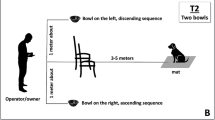Summary
The weakly electric fish Gnathonemus petersii increases the discharge frequency of its electric organ if it detects a change in its environment. This reaction appears if a number N of electroreceptors is stimulated above the threshold. The number N is not dependent upon the relative position of the stimulated receptors (within the investigated area) nor upon the degree to which the stimulus is raised above the threshold (see Fig. 5). Probably one class of electroreceptors, the so-called Knollenorgane, play a decisive role in detection. By means of a training experiment it was determined that Gnathonemus is able to distinguish between two signals which differ in their spatial distribution on the surface of the fish. This ability is largely independent of the magnitude of the signals.
Zusammenfassung
Wenn der schwachelektrische Fisch Gnathonemus petersii mit Hilfe seines elektrischen Organs eine Änderung seiner Umgebung bemerkt, reagiert er durch Erhöhung seiner Sendefrequenz. Diese Reaktion erfolgt dann, wenn eine gewisse Anzahl N von Elektrorezeptoren überschwellig gereizt wird, wobei es auf die relative Lage der gereizten Rezeptoren zueinander innerhalb der untersuchten Gebiete nicht ankommt und es auf die Zahl N keinen Einfluß hat, ob die Rezeptoren schwach oder stark überschwellig gereizt werden (s. Abb. 5). Bei der Detektion sind wahrscheinlich die sog. Knollenorgane, ein bestimmter Typ von Elektrorezeptoren, maßgeblich beteiligt. In einem Dressurexperiment wird geprüft, ob Gnathonemus außer der Information über die Zahl der gereizten Elektrorezeptoren auch die Information über ihre Lage nutzt: Gnathonemus kann zwei in der örtlichen Verteilung auf der Fischoberfläche verschiedene Signale weitgehend unabhängig von deren Amplitude unterscheiden.
Similar content being viewed by others
Literatur
Belbenoit, P.: Conditionnement instrumental de l'électroperception des objects chez Gnathonemus petersii (Mormyridae, Teleostei, Pisces). Z. vgl. Physiol. 67, 192–204 (1970).
Bennett, M. V. L.: Electroreceptors in mormyrids. Cold Spr. Harb. Symp. quant. Biol. 30, 245–262 (1965).
- Mechanisms of electroreception. In: P. Cahn (ed.), Lateral line detectors. Indiana University Press 1967.
Bussgang, J., Johnson, N.: Polysensoric detection under local and central signal processing constraints. Air Force Systems Command Griffis Air Force Base, New York, Technical rep. No. RADC-TR-67-140, April 1967.
Enger, P. S., Szabo, Th.: Activity of central neurons involved in electroreception in some weakly electric fish (Gymnotidae). J. Neurophysiol. 28, 800–818 (1965).
Hagiwara, S., Morita, H.: Coding mechanisms of electroreceptor fibers in some electric fish. J. Neurophysiol. 26, 551–567 (1963).
Harder, W.: Die Beziehungen zwischen Elektrorezeptoren, elektrischem Organ, Seitenlinienorganen und Nervensystem bei den Mormyridae (Teleostei,Pisces). Z. vgl. Physiol. 59, 272–318 (1968).
—, Schief, A., Uhlemann, H.: Zur Funktion des elektrischen Organs von Gnathonemus petersii (Gthr. 1862) (Mormyriformes, Teleostei). Z. vgl. Physiol. 48, 302–331 (1964).
—: Zur Empfindlichkeit des schwachelektrischen Fisches Gnathonemus petersii (Gthr. 1862) (Mormyriformes, Teleostei) gegenüber elektrischen Feldern. Z. vgl. Physiol. 54, 89–108 (1967).
Lissmann, H. W.: On the function and evolution of electric organs in fish. J. exp. Biol. 35, 156–191 (1958).
Szabo, T.: Sense organs of the lateral line system in some electric fish of the Gymnotidae, Mormyridae and Gymnarchidae. J. Morph. 117, 229–250 (1965).
- Morphologische und funktionelle Aspekte bei Elektrorezeptoren. Verh. dtsch. Zool. Ges., 54. Jahresverslg 1970. 1971.
—, Fessard, A.: Le fonctionnement des électrorécepteurs étudié chez les Mormyres. J. Physiol. (Paris) 57, 343–360 (1965).
—, Roth, A.: Comportement des potentiels propagés dépendent de la modulation des potentiels récepteurs autoactifs des Knollenorgane. C. R. Acad. Sci. (Paris), Ser. D 265, 807–809 (1967).
Author information
Authors and Affiliations
Additional information
Der Verfasser dankt dem Bundesministerium der Verteidigung für die Bereitstellung der Mittel für diese Untersuchungen.
Rights and permissions
About this article
Cite this article
Paul, D. Zur Signalverarbeitung im elektrischen Empfangsorgan des schwachelektrischen Fisches Gnathonemus petersii (Mormyriformes, Teleostei). Z. Vergl. Physiol. 76, 193–203 (1972). https://doi.org/10.1007/BF00455962
Received:
Issue Date:
DOI: https://doi.org/10.1007/BF00455962




